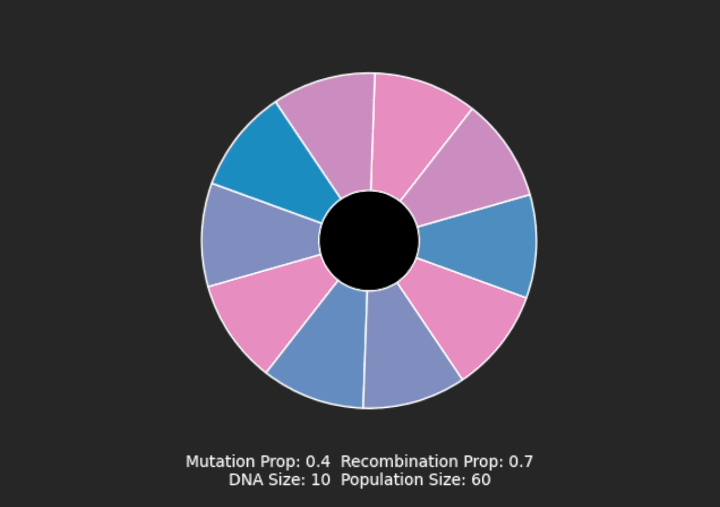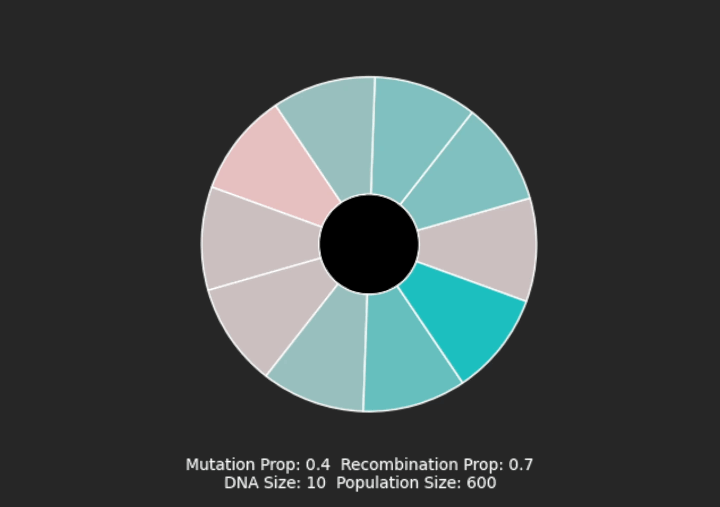Genetic Eyegorithm
- Putting Evolution In The Eye -
In Progress
Introduction
The idea of this project arose from the desire to visualize a genetic algorithm and the underlaying process, which is based on the concept of genetic inheritance and the evolution. Thus, on the one hand, the learning process of the algorithm can be followed visually, and on the other hand, the natural process behind it, which in broader sense also shaped and formed our bodies, can be observed in a new and simplified version and anew experiencend and understood.
Concept
Genetic algorithms belong to the group of evolutionary algorithms. They are based on coded DNA, which can mutate and be recombined and which constitutes an individual. From populations of individuals, descendant generations are generated by fitness-proportional selection through a cross-over of parental DNA. Genetic algorithms are used for search and optimization procedures. They aim at a goal, which is evaluated by the fitness function. Fitness in this case the equivalence of is a chosen color.
The human eye serves as a projection surface, whose color is genetically inherited. Eye color is determined by a significant impact by two genes that encode the melanin content, which is responsible for the coloring of the pigments. The structure of the stroma, which scatters the incident light, provides the bluish and greenish coloration of the less pigmented irises, while reddish and violet eyes reflect the color of the blood vessels when very little pigment is present.1 The visualization approach chosen was to represent the color scheme in a simplified way using a randomized color distribution for only one simplified gene. An genetic algorithm is then led by evolutional processes searching the color of choice.
Method
The genetic algorithm is inspired by Patrick Kim’s Talk and JavaScript algorithm. I translated my own version of it into Python, which I also used to implement a first visualization approach. The animations shows the fittest individual of each population, emerging of the last generation by fitness-based selection and cross-over of the parental DNA. The mutation and recombination probabilities during offspring creation as well as the population and the DNA sizes have an influence on the rate the algorithm requires finding the desired color.



Future Prospects
First of all, it is planned to connect the genetic algorithm as it is to Touchdesigner in order to be able to display a more realistic version of the eye and its color spectrum. Here, all individuals of a generation are to be considered and not only the fittest.
Even though Touchdesigner offers the possibility to change the parameters live, they are not controllable via an interface. In order to give the viewers themselves the possibility to interact with the algorithm, either the opportunity for live interaction through movement via Touchdesigner is to be implemented, or the algorithm is going to be transferred into a game engine.
In addition, I would be curious to study the visualization of the genetic process of eye color formation in detail and apart from the genetic algorithm with more accuracy regarding the genotype-phenotype relation, as far as we have understood it so far. Fundamentally, my interest lies in opening up the understanding of biology and genetics to a larger part of humanity through artistic explorations, and thereby bringing the conversation about a topic that is becoming increasingly relevant into the realm of discussion for all of society.
For the future I am interested in working on further projects that deal with the visualization of natural processes in new forms. As an example, I plan to translate the evolutionary processes of an ecosystem, in which several factors are interdependent, in their form of activity and exchange into a system of gaseous exchange.